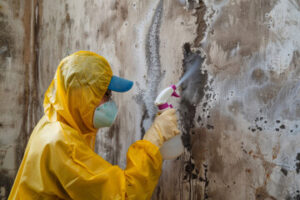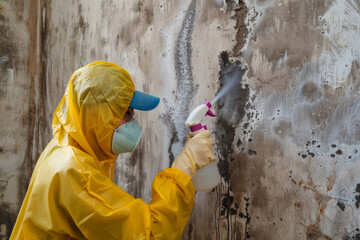Molds can cause a wide range of health issues including allergic reactions like sneezing, coughing and shortness of breath. The best way to protect against mold is to prevent it from growing in the first place.
The most important factor in preventing mold growth is moisture control. This includes keeping surfaces dry, scrubbing porous materials regularly and fixing leaks immediately. Contact Mold Removal Salt Lake City for professional help.
Mold growth produces airborne spores that can spread to unaffected areas and trigger allergies or asthma. They can also weaken or deteriorate building materials such as wood, drywall, and insulation, leading to costly repairs. Timely removal helps prevent these costs and protects your home or building from further damage.
Containment is the process of isolating areas affected by mold before remediation begins. This helps to avoid spreading mold spores to unaffected areas of the building or home and ensures that all steps taken during the remediation process are effective. Containment is accomplished using plastic or polyurethane sheeting and filtration devices like air scrubbers to control the flow of spores in and out of the containment area. This will help to ensure that you and those helping with the removal do not inhale spores that may cause reactions.
Once the mold contaminated areas are contained, they can be cleaned and treated. Professionals use a variety of methods including scrubbing, sanding, and sometimes complete removal of the affected materials. The cleaning and treatment of the surfaces and materials also reduces moisture levels and helps to prevent future mold growth.
After the moldy areas have been cleaned and treated, a post-remediation verification is performed to ensure that all the spores have been removed and the indoor air quality has returned to normal. If necessary, additional precautions can be taken to prevent recurrence of the mold problem, such as sealing the area or installing an exhaust fan.
Mold problems can be stressful, especially for homeowners and property owners. Timely removal can alleviate these concerns and help to maintain a safe, healthy environment for residents and guests. Keeping up with routine maintenance and performing regular inspections can also help prevent mold growth and keep it from growing out of control.
Removal
Molds thrive in warm, moist air and derive their nutrients from dead organic material such as wood, paper, fabrics and food. They can also absorb chemicals, such as those in paints and adhesives. Mold spores are dispersed through the air, and can cause respiratory issues such as coughing, wheezing and rashes in some people. Often, the symptoms are mild but can become more serious if a person has preexisting conditions such as asthma or chronic obstructive pulmonary disease. Toxic molds, such as Aspergillus, produce toxic spores that can lead to serious health problems, including infection.
To get rid of mold, you must remove and sanitize the area. You can use a variety of cleaning products, such as hydrogen peroxide or white vinegar, which can be mixed with water to create a spray or a solution to scrub the surface. Disinfectants, such as chlorine bleach or sodium hypochlorite, can also be used to clean mold.
A thorough inspection of the affected areas is required to find the source of the mold growth. If you do not find and fix the underlying problem, the mold will likely return. This may involve repairing leaks, improving ventilation, and controlling humidity levels.
When you begin the cleaning process, wear gloves and a mask to protect yourself from direct contact with the mold spores. It is important to work in a well-ventilated area and open windows or doors to allow fresh air to circulate. You should also remove upholstered and fabric furniture, as the mold spores can imbed themselves into these materials. It is also a good idea to remove and discard cellulose-based items such as paper and cardboard. This will prevent the spores from spreading to other areas of your home as you clean.
After scrubbing the moldy surface, rinse it with water and sanitize it using a disinfectant. It is important to completely dry the area afterward, to avoid mold returning. This can be done by using fans, a dehumidifier or by opening windows in the room. Once the area is thoroughly dried, it is important to seal any contaminated cleaning supplies or rags in a plastic bag and dispose of them outside of your home.
Cleaning
Cleaners are used to physically remove mold from surfaces like walls, floors and carpeting. These cleaners typically contain chemicals such as bleach or ammonia that can destroy visible mold and also penetrate porous materials like drywall to remove hidden spores. Alternatively, antimicrobial cleaning products that are specifically formulated for mold can be used.
These cleaners are typically much faster and more effective than standard surface cleaners and can be found at most home improvement stores. When using any type of chemical cleaner, it is important to wear personal protective equipment (gloves, mask and goggles) to avoid breathing in any vapors or particles. Using plastic sheeting to seal off the affected area can also help prevent mold spores from spreading to other parts of your home.
For small areas of surface mold, undiluted white vinegar can kill 82% of all mold species. This solution can be sprayed directly onto the surface and allowed to sit for about an hour before wiping away with a damp cloth. For more stubborn stains, bleach or commercial tile cleaner can be applied and scrubbed with a nylon brush.
If the mold infestation is severe or involves a significant amount of water damage, it may be necessary to hire professional mold removal services. Large areas of mold growth, especially those involving contaminated water or styrofoam insulation, may require specialized equipment and can only be safely removed by a certified mold remediation specialist. Black mold (Stachybotrys chartarum) is another serious problem that requires professional attention and should never be attempted by the homeowner.
Once the area has been cleaned, it is important to address any moisture problems and dry the affected areas as quickly as possible. Covering the affected area with a paint or caulking over the mold will only cause it to return and spread to other areas of the home.
If the area is not ready to be reoccupied, it is a good idea to use a box fan to direct the flow of air outside. It is also a good idea to remove any furniture, rugs or other cellulose-based products that are in the affected room so they can be cleaned and dried properly.
Prevention
Molds are a natural part of the environment, and they cannot be completely eliminated. However, mold growth can be controlled and managed through preventive measures and proactive cleanup after a problem arises. Preventive measures include identifying and addressing the root cause of the problem, such as leaks or high humidity levels, and regularly cleaning and maintaining porous surfaces. In addition, regular cleaning can help reduce the number of spores in your home, which can also lower your risk of mold allergies and other health problems.
The first step in any mold removal process is to isolate affected areas to prevent the spread of spores. This may involve sealing off rooms and directing airflow through an anteroom to minimize dispersion of active spores. Using HEPA-filtered air filters in HVAC systems can help keep the spores from entering other sections of the house. Isolation is especially necessary in high-risk areas like behind walls, in attics and other hard-to-reach places.
Once a mold outbreak is identified, it’s important to determine the extent of the problem and identify the type of mold species that is present. This information can be helpful in making remediation decisions. In some cases, particularly those involving highly toxic species, it may be necessary to consult with a mycologist.
If the outbreak is small and limited to non-porous surfaces, simple clean up and containment may suffice. For example, a minor outbreak in a tile or glass bathroom can often be cleaned and contained with white distilled vinegar, which is mildly acidic and kills 82% of mold species. For larger outbreaks, an anteroom should be established with negative pressure to limit the movement of spores between work and unaffected areas.
Water damage is a common cause of mold problems, and it’s essential to act quickly to prevent further problems. The best way to do this is by removing and cleaning impacted items as soon as possible and using fans to direct the flow of air outside. It’s also important to dry and dehumidify the area as soon as possible, as mold spores can begin growing within 24-48 hours.

